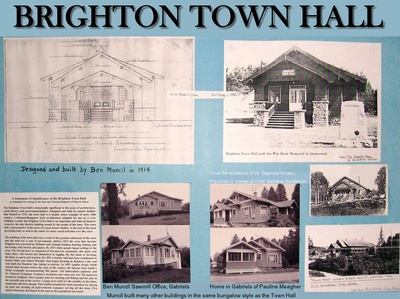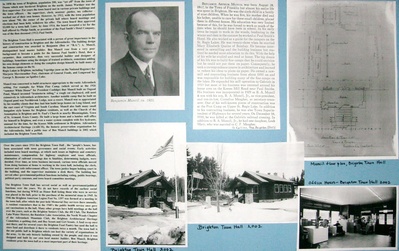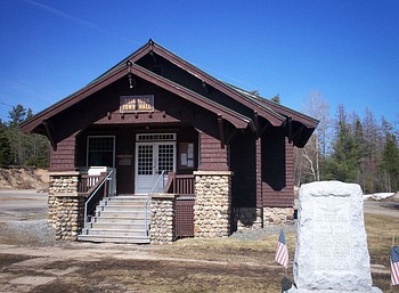The Brighton Town Hall is on New York Route 86 in the Town of Brighton, New York.
 "Brighton Town Hall" by Pat and Tom Willis, photo of display taken 2/2009. Click on the image to enlarge the display.
"Brighton Town Hall" by Pat and Tom Willis, photo of display taken 2/2009. Click on the image to enlarge the display.  "Brighton Town Hall" by Pat and Tom Willis, photo of display taken 2/2009. Click on the image to enlarge the display.
"Brighton Town Hall" by Pat and Tom Willis, photo of display taken 2/2009. Click on the image to enlarge the display.  Brighton Town Hall, 1982
Brighton Town Hall, 1982  "Brighton Town Hall" by Pat and Tom Willis, photo of display taken 2/2009. Click on the image to enlarge the display.
"Brighton Town Hall" by Pat and Tom Willis, photo of display taken 2/2009. Click on the image to enlarge the display.  Brighton Town Hall, 2009
Brighton Town Hall, 2009
A Statement of Significance of the Brighton Town Hall
As Submitted for Listing on the State and National Registers of Historic Places
The Brighton Town Hall is historically significant in the areas of architecture, social history and government/politics. Designed and built by master builder Ben Muncil in 1914, the town hall is a largely intact example of early 20th century Craftsman/Bungalow Style architecture adapted for use as a civic building. Locally the Brighton Town Hall is an important and beloved historic resource, the only historic building owned by the people of the town. This town hall, representative of the work of a local master builder, is the seat of the town governing body as well as the center for many social activities over the years.
The building of the town hall was a result of the gradual settlement of the town and the need for a seat of government. Before 1815 the area that became Brighton was traversed by Mohawk and Abenaki Indians, hunting, fishing, and harvesting wild berries and plants. By 1815 white people began settling in the area. The terrain here is composed of forested low mountains, flat plain, and many lakes. The forests lent themselves to logging, the flat lands to farming, the lakes to sports and tourism. By 1851 a lumber mill had been established in Keeses Mills, and James Wardner had begun farming in Rainbow Lake and soon built the Rainbow Inn, taking in tourists. In 1859 Apollos (Paul) Smith started what became before the turn of the century the famous Paul Smith's Hotel, eventually accommodating 500 guests. The tuberculosis epidemic and Dr. Edward Livingston Trudeau’s mountain cure soon saw two TB sanatoria located in Brighton. More people came for hunting and fishing and for jobs in the sawmills and at the resorts. Camps were built for the wealthy on the lakes, employing still more people. Paul Smith extended his hotel operation by buying up land and forming an hydro-electric company serving all the town. Five small settlements developed in the town as the population increased.
In 1858 the town of Brighton, population 200, was “set off” from the town of Duane which now bordered Brighton on the north. James Wardner was the first supervisor. For years the town board met in various private buildings and the town officers - the supervisor, clerk, assessor ,justice, tax collector - worked out of their own homes. However, by 1912, with the town population now about 700, the owner of the private hall where board meetings and elections had been held, withdrew his offer. The town board then approved $3,000 for a town hall. Later, by June 1914, the board accepted a lot for the hall offered by Phelps Smith, as president of the Paul Smith’s Hotel Company, son of the then deceased (1912) Paul Smith.
The Brighton Town Hall is associated with a person of great importance in the history of construction in Brighton and the Adirondacks. The building design and construction was awarded to Benjamin (Ben or “B.A.”) A. Muncil, distinguished local master builder. Ben Muncil rose from a very poor background to become a guide for the famous Paul Smith’s Hotel, then a carpenter, then contractor, then very successful builder and designer of buildings. Sometimes using the designs of trained architects, sometimes adding his own design elements or doing the complete design himself, he built many of the famous camps on the St. Regis Lakes in Brighton, including Topridge (now on the National Register) for Marjorie Merriweather Post, chairman of General Foods, and Longwood for George S. Brewster on Spitfire Lake.
Muncil was concerned to build structures appropriate to the rustic Adirondack setting. For example, for White Pine Camp, (which served as the 1926 “summer White House” for President Coolidge) that Muncil built on Osgood Pond, Muncil invented “brainstorm siding,” a rough cut clapboard, still used extensively in Adirondack architecture. Another notable camp that he built on Osgood pond was Northbrook Lodge, now a resort. Muncil was so appreciated by his wealthy clients that they had him build large homes on Long Island, and the east coast of Virginia and South Carolina. Muncil also built many small bungalow style homes for Brighton residents, as well as the Church of the Assumption in Brighton and St. Paul’s Church in nearby Bloomingdale, Town of St. Armand, Essex County. He built a large home and a lumber mill office for himself in Brighton, and even a water system complete with fire hydrants, unusual for the time, for the Keeses Mills settlement in Brighton. Adirondack Architectural Heritage (AARCH), the historic preservation organization for the Adirondacks, held a public tour of Ben Muncil buildings in 2002 which included the Brighton Town Hall.
Over the years since 1914 the Brighton Town Hall , the “people’s house", has been associated with town governance and social events. Early activities included town board meetings, at which such issues as highway and cemetery maintenance, compensation for highway employee and town officials, elimination of railroad crossings due to fatalities, determining budgets, were decided. Over time, as town business increased, various town officials moved from doing business at home to working in the town hall, including the clerk, assessor and code enforcement officer. The town justice began holding court in the building, and the supervisor maintains a desk there. The building has served other governmental/political functions including voting, public hearings, political party caucuses, and town board committee meetings.
The Brighton Town Hall has served social as well as government/political functions over the years. We do not have records of the earliest social functions, but during WWII an Honor Roll listing those who were in service was placed in the hall, prior to the purchase of the memorial stone in 1945. In 1946 the Brighton American Legion Post No. 1397 was formed at a meeting in the town hall, after which the post held Memorial Day services there annually. A resident remembers that in the 1940’s the public health service once gave out vaccinations in the hall. Many other groups have held meetings at the hall over the years, such as the Brighton Seniors Club, the 4H Club, The Rainbow Lake Water District, the Rainbow Lake Association, the North Woods Chapter of the Adirondack Mountain Club, the Brighton Architectural Heritage Committee, a quilting club, and Boy Scouts and Girl Scouts. A food co-op once met there, and for several years the Brighton Food Pantry has used the hall to store food and distribute it there to residents twice a month. The town hall is the one public hall in Brighton which can host the variety of organizations in the area. As the only historic building owned by the people, and since it was designed and built by our own local master builder, Ben Muncil, Brighton residents prize the town hall as a most important part of their heritage.
Brighton History Days have been held one weekend each summer since 1994, sponsored by the Brighton Architectural Heritage Committee.
National Register of Historic Places Registration Form (pdf)



